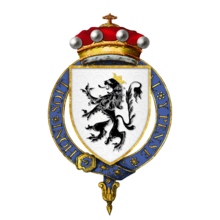Thomas de Morley, 4th Baron Morley, KG (c. 1354 – 24 September 1416) was a baron in the Peerage of England, Lord of Morley, Hingham, Hockering, &c., in Norfolk, de jure Lord Marshall, hereditary Earl Marshal of Ireland, and a Privy Councillor. He was summoned to parliament from 20 October 1379 to 3 September 1416.

Thomas Morley was the second but eldest surviving son and heir of Sir William de Morley, 3rd Baron Morley (d. 30 April 1379) by his spouse Lady Cecily Bardolf (d. 23 November 1386), daughter of Thomas Bardolf, 2nd Baron Bardolf.
In 1375 he was a Knight serving in Brittany in the expedition of the Duke of Brittany and Earl of Cambridge. In 1386, upon rumours of an intended invasion, he was, as Lord Morley, the Chief Commissioner ordered to survey Great Yarmouth and make provisions for its defence.
In 1391 Lord Morley received permission to go on crusade in Prussia.
In 1399 he accompanied King Richard II on his disastrous journey to Ireland. In July 1415 he set out with King Henry V on the expedition which culminated in the great victory of the Battle of Agincourt, but it does not appear, however, that he fought in the battle. In 1416 he was Lieutenant and Captain-General of forces assembled to proceed to France.[1]
Lord Morley died later that year at Calais, where he was lodging at the house of a merchant,[1] After a service at the Church of Notre Dame in Calais, at which both King Henry V and Sigismund, Holy Roman Emperor, were present,[1] his body was returned to England and buried in the Austin Friars Church at Norwich, Norfolk.
Lord Morley married three times:
- (1) before 3 April 1374, Joan de Hastings[2] (Norfolk, 1357 - before 1380), daughter of Sir Hugh de Hastings, Knt. (died c. 1369), by Margaret de Everingham, daughter of Adam de Everingham 2nd Baron Everingham, by whom Lord Morley had one son, Sir Robert de Morley, Knt. (circa 1375 - before 12 November 1403), d.v.p., who married before August 1394 Isabel de Molines and had Thomas de Morley, 5th Baron Morley. She is buried in the Church of the White Friars, Norwich, Norfolk.
- (2) before 10 June 1380, Elizabeth (surname unknown).
- (3) before 21 October 1390 (date of Papal dispensation), Anne[3] le Despencer, daughter of Edward le Despencer, 1st Baron le Despencer and Lady Elizabeth Burghersh and widow of Sir Hugh de Hastings, Knt., (d.1386), of Elsing, Norfolk. She died 30 October 1426, and was buried in the Church of the Austin friars, Norwich. By Lord Morley, she had no issue.
References
edit- ^ a b c The Hundred Years War (Part III): Further Considerations. BRILL. 2013. pp. 285–300. ISBN 978-90-04-24565-5.
- ^ D. Richardson, Magna Carta Ancestry.
- ^ Plea Rolls of the Court of Common Pleas; National Archives; CP 40 / 629; 5th entry, plaintiff in Suffolk; Year: 1418
- Burke, Sir Bernard, Ulster King of Arms, Dormant, Abeyant, Forfeited, and Extinct Peerages of the British Empire, London, 1883, p. 382.
- Dictionary of National Biography, Compact Edition, Oxford University Press, 1975.
- Richardson, Douglas, Plantagenet Ancestry, Baltimore, Md., 2004, pps: 288 and 517. ISBN 0-8063-1750-7
- Petition to exercise the office of Earl Marshal of Ireland by deputy, Rotuli Parliamentorum vol iii, P 130, no16 - 1381 & 1382, 5 Richard III